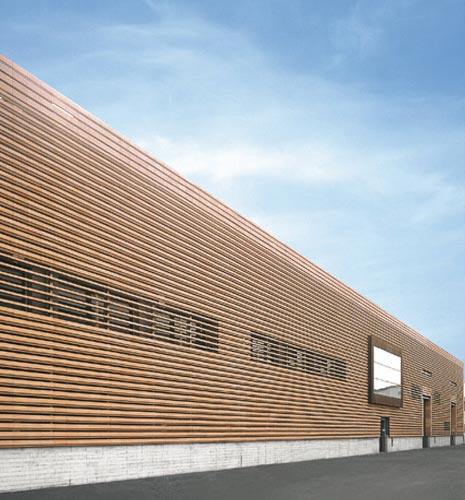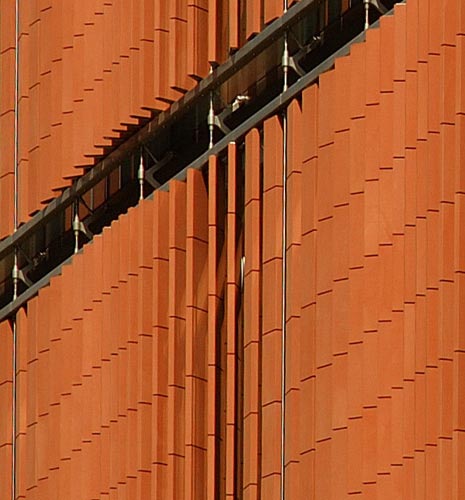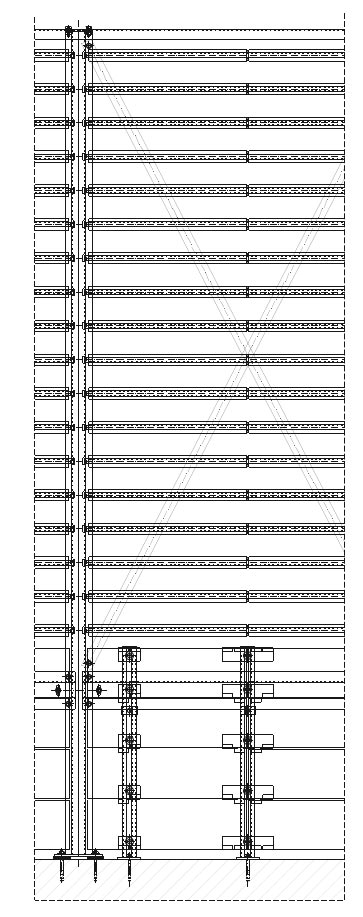Cladding
Cotto layer
The outer layer, technically defined “sealing layer”, has the role of both protecting internal elements from rainfall and characterizing the style of the building. The design principle of the curtain wall lies in the static autonomy of each single element of the facing and in the elimination of the mortar core. Not directly adhering to the support- ing structure, the cladding elements are free to move according to their own coefficient of expansion (inde- pendently of the supporting structure’s movements), and to follow the settling and oscillations of the load-bearing structures thanks to the anchors’ elas- ticity. The absorption of elastic move- ments between support-tng structure and cladding is generally resolved through the presence of joints, which permit free expansion without the ele- ments interfering with each other. The joint is nothing other than the space which separates the perimeter of the elements that form the clad- ding, and has the specific task of per- mitting their free movement caused by temperature excursion or settling of the load-bearing structures or fixing mechanisms. The joints may be open or closed.
Although the layer of cladding can be in a variety of materials, what really interests us here is to highlight terracotta’s contribution to today’s architecture, a material of ancient tradition yet currently caught up in a roductive process of modernization.; Terracotta tiling in its variegated range of standard and special elements with different typologies, shapes and sizes, has always expressed to the full its potential in external cladding, for at least three reasons: - it is a stable and durable material which, if correctly and intelligently used, offers great aesthetic impact to architectural exteriors and excellent performance with reduced (if not zero) maintenance cost even over long periods (50-100 years); - it is a material traditionally used in building and architecture throughout all over the world and its familiarity therefore makes it easier to achieve a continuity between the new and what is already existing; - it is a material which, although “ancient” and “historicized”, has always been able to express innovation of form and construction, such as to enable it to both evolve technologically and dialogue with the languages of other construction materials, whether traditional or contemporary. Cotto tiles in the cladding of exteriors, on one hand, visually represent continuity with the past (thus appearing as highly recognizable elements) and on the other, express great evolutive flexibility in that they are able to respond to the new and most complex technological expectations of today’s building, which often push towards innovative, “light” products with limited thickness.
An experimental tendency - within the general revival of cotto technology which now distinguishes international architecture - is one that aims to create an innovative product, progressively reducing the thickness of the cladding itself and confining clay derivatives to the outermost layers. Product innovation marries the innovation of process and building methods, where industrial logic and methodologies are adopted and the mechanical assembly of cotto elements is favoured. As regards brick, glorious element of tradition, in which some find a series of “unsuitable” or at least “dated” connotations (rough craft-like quality, irregularity, wet method of mounting, mass and static solidity linked to the concept of masonry, to wall thickness), today the technological research on terracotta is leading to the development of innovative products like preassembled panels mounted on to a more economical wall structure. The most evident trend of recent years is undoubtedly directed at reducing the thickness of cotto elements and expanding the other dimensions which define their visible size on the cladding surface. A reduction in thickness indisputably lowers costs linked to excess material and weight and this in turn leads to more economical transportation, machinery shifting and labour. Most importantly, in the case of cladding anchored to a cavity wall, reduced thickness would also mean smaller mechanical fixing systems.





